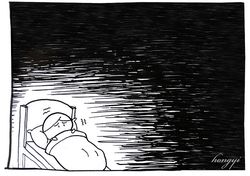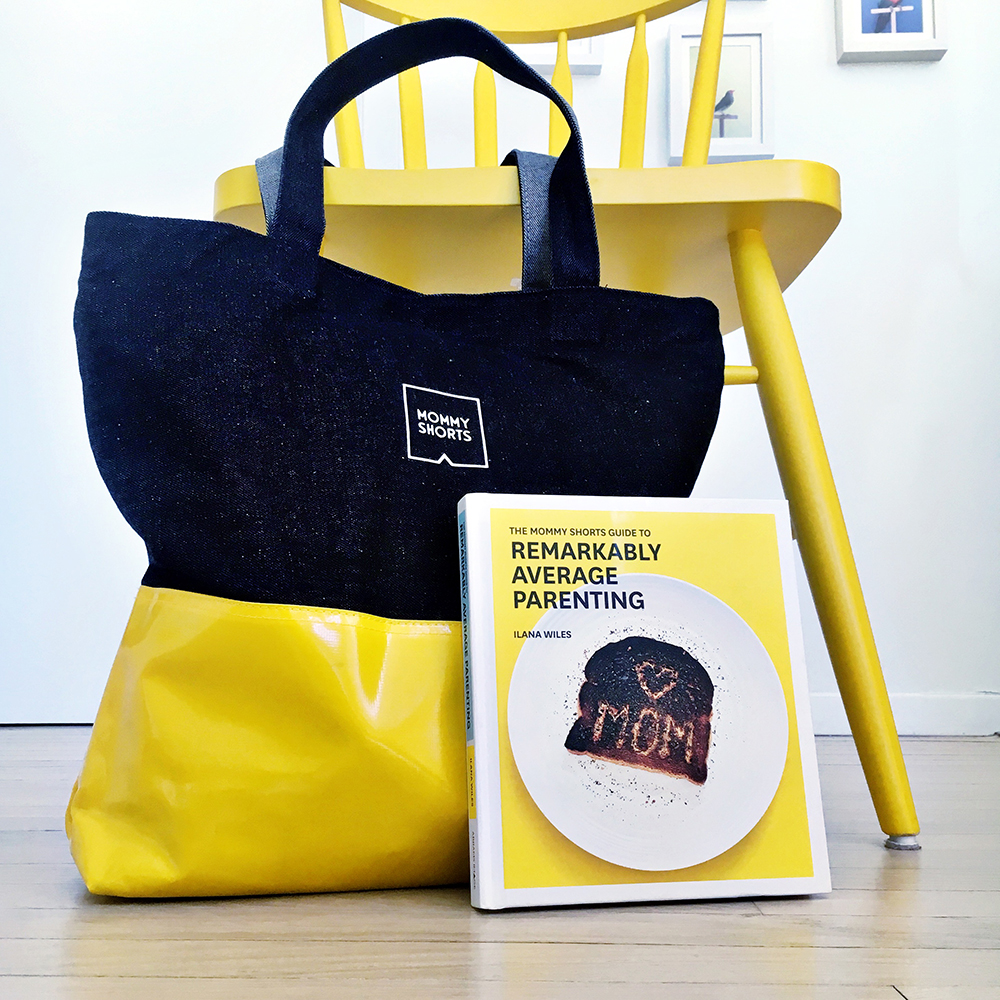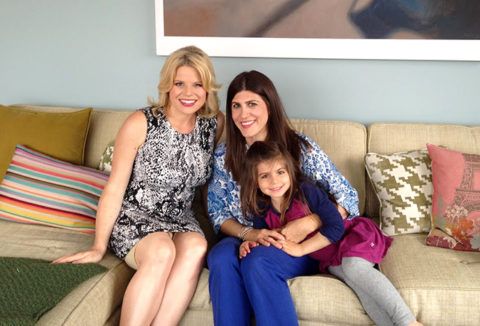How To Get Your Child Over A Fear Of The Dark
 This week's question for Dr. B. comes from Morgan of The Little Hen House.
This week's question for Dr. B. comes from Morgan of The Little Hen House.
Yes, Morgan actually owns hens. But I gather it is less a farmgirl thing and more of an urban locavore thing. Although does that mean she kills the chickens for food? Because judging by the names she's given them— Lulu, Kitty, Gnocchi and Dagny— I'll assume she treats them more like pets than dinner. Except Gnocchi. He's obviously toast.
Morgan's question isn't about hens (good thing because Dr. B would not be able to help). It is about her three and a half year old, Emma and her fear of the dark. (I hear you, Emma— I hate the dark too!)
Dear Dr. B,
My three and a half year old insists on leaving the light on at night because she gets scared of various objects in her room like her stuffed animals. She even claims the Cat in the Hat (with "big, sharp teeth") is outside her window. She has two small lamps on her bedside tables, which make the room bright enough to see everything and I am happy to leave on. But my daughter wants both the lamps on AND her overhead light. It's brighter than daylight in there. It ends up taking her an hour to fall asleep, but she freaks when I turn out the "big" light.
Sigh…. How should I deal with her fear of of the dark so it doesn't get in the way of her sleep?
Signed, Morgan
Dear Morgan,
Most children develop one specific fear at some point during their childhood and fear of the dark is one of the most common in preschoolers. Fears often emerge when children develop their capacity to use their imaginations but do not yet have a firm grip on the difference between reality and fantasy. Here are some steps you can take to help your child conquer her fears:
1) Decide on a Time to Discuss It: Choose a time other than bedtime to discuss your child's fear with her since some children use nighttime fears to delay bedtime and to get some extra one on one attention.
2) Listen and Understand: Do your best to pinpoint what your child is actually afraid of. For instance, knowing that your child is afraid of scary objects or a specific character such as “Cat in the Hat” outside the window is much more valuable than knowing that she is simply afraid of the dark. You can use this information to help you determine the best strategy to overcome her fear (e.g., moving certain objects out of the room at night or not reading Cat in the Hat before bed). Do not play into your child’ fears by checking to make sure that the Cat in the Hat is not outside the window but let her check if she thinks it will help.
3) Validate Feelings, Not Fears: When your child expresses a fear, make sure she feels heard and don’t dismiss her feelings as silly or childish. Instead, restate what she shared with you in her words (e.g., “You feel scared. You are afraid of the Cat in the Hat when the lights are turned off). Explain that all people feel scared at times and it’s okay to be scared. Also, praise your child for using her words to tell you how she feels.
4) Provide Information and Reassurance: Give your child factual information about her fears in an effort to reassure her that she is safe. For instance, explain the difference between real people and characters in stories. Don’t try to talk her out of the fear, just simply state the facts. Also, remind her that Mommy and Daddy will keep her safe.
5) Discuss Coping Strategies: Explain to your child that you want to help her get over her fear of the dark and ask her what would help make her feel more safe and secure. Offer suggestions and ideas if needed. Some ideas include adopting a special safety blanket or stuffed animal, a night light, soft music, a flash light to turn on as needed, or changing the bedtime routine.
You can also teach your child to use positive self-talk when she feels afraid. Positive self-talk are helpful phrases such as “I am not afraid. There is nothing to be afraid of in my room. Its just the dark. Mommy and Daddy are home and will keep me safe.”
You can also devise a plan where you will check on her periodically throughout the night. Or you could suggest to gradually turn off one new light each night and reward her with a special treat for each light and then a big prize when all the lights are turned off for a full night.
6) Select a Strategy to Try: Discuss the ideas that you generated with your child and let her decide which one to try. If some ideas are not possible, explain why (e.g., I am concerned about leaving the big light on because it makes it hard for you to fall asleep, wastes electricity, costs money, etc.) but then remind her of other ideas you discussed that are similar.
7) Implement a Plan and Revise it if Needed: Once you decide on your plan, implement it, and see if it is successful. If it doesn’t work, discuss it the following day, determine why it didn’t work, and then try something new.
Again, fear of the dark is very common among young children and most children will grow out of fears in a few weeks or months. You may need to follow the steps outlined above or the issue may resolve itself on its own. If the fear persists beyond a few months or a developmentally appropriate age, consider talking to a professional. Either way, the best strategy is to be patient and sensitive. You want to send the message that feelings of fear are normal and parents can help. Eventually you and your child will not only conquer her fear of the dark, she will also learn some important coping and problem-solving skills to apply to different feelings and experiences.
Good luck!
Dr. B
If you have a question for Dr. B, our resident developmental psychologist, please email me at myshort@mommyshorts.com.
If you want to read more from Morgan, visit The Little Hen House. Today she is specifically talking about her struggle with Emma's fear of the dark.

























I wish I would have read this about 6 years ago. My oldest is 7 and she still sleeps with a night light. Perhaps I can break this cycle with my youngest.
Great post and great information.
But I’m still dying from “Except Gnocchi. He’s obviously toast.”
Somehow I knew Dr. B wasn’t going to go with, “Suck it up, kid. Don’t be a pussy.” She has mad knowledge.
I actually could use this advice right now because I- er, I mean- my son has a very active imagination.
you are wicked lucky to have Dr. B. in your family. she’s obviously a parenting genius. next i’m going to learn you have a plastic surgeon, lawyer and gourmet chef in your tree!
and yes, I did use the word ‘wicked’ it making a come back, along with ‘rad’.
Dr. B is my new BFF! I’m totally doing every single thing she tells me to do. I learned a long time ago that it’s best to strictly follow a therapist’s orders. Mostly because my mom is one, and my life is easier when I just say “yes” to her. Thanks Dr. B.
Dr. B’s husband is a lawyer. And my stepfather is an accountant which comes in handy as well. But I would trade them all in for a plastic surgeon relative!
Dr. B’s approach is always with a specific actionable plan. It’s what makes her posts so helpful. She tells you exactly what to do.
I am patiently waiting on your guest post— “Tough Love Parents and the Children Who Hate Them”.
Gnocchi was asking for it, don’t you think?
The course of action might be different, but I have to imagine that at the age of seven, you can still break a habit.
I hear you. I will never go to sleep with the closet doors open. Who knows what’s in there!
You mean I can’t just turn off the lights and say SUCK IT UP?
Oh, man.
I kid, I kid. This is good advice.
Perfect timing for me! Big Roo has been a little scared of the dark but I can’t tell if he’s really scared or just making up an excuse to not go to sleep (it usually starts with “ummmm, mom?” like he’s coming up with an excuse). Regardless I’m definitely trying your tips. Thanks!
My partner’s son, when he was a toddler, kept saying he was afraid of “monsters” outside his window. One night his mom went into his room and heard the monsters for herself — and they were REAL! Turns out there were a gang of neighborhood college-age boys who would drink and party LOUDLY in the alley outside the window every night. No wonder it was hard for him to sleep in that room! They wound up moving the child’s toddler bed to an alcove at the end of the hall outside mom’s room, and just using his bedroom as a daytime playroom.
I also know a mom who kept sending her preschool-aged daughter back to bed while the daughter kept getting up complaining that there was a snake in the bed. When Mom insisted she get back in the bed, the girl put her feet on the bed but held onto the bedpost and leaned as far away from the bed as she could get. Mom finally said “look, I’ll show you there’s no snake in the bed!” She pulled back the covers, and… THERE WAS A SNAKE IN THE BED!! A huge snake. Seriously.
Kids are not always just imagining things.
[…] Is your toddler afraid of the dark? Here are some GREAT tips from a developmental psychologist. -Mommy […]